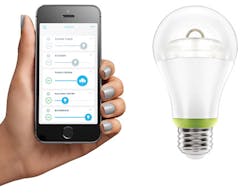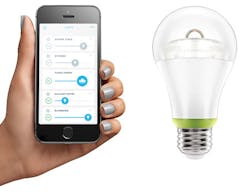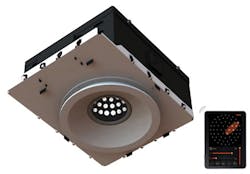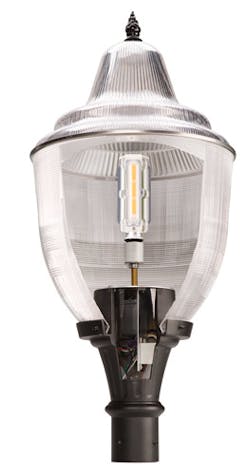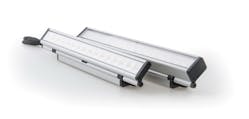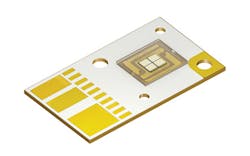The options in networking for SSL products continue to expand, reports ROGER ALLAN after perusing the LightFair exhibits, but the LED-based lighting industry is delivering in terms of innovative new SSL features.
The exhibits at this year's LightFair International (LFI) bristled with the latest new LED-based products, performance advances, innovative indoor and outdoor lighting fixtures, novel retrofit approaches, and dazzling remote control and networking methods from anywhere and by just about anyone connected using the Internet of Things (IoT) concept. LED lighting technology and design has matured to the point where it has spawned an advanced level of user interaction with the world of illumination. Meanwhile, solid-state lighting (SSL) manufacturers continue to improve light quality, innovate in form factor, and deliver products with more pleasing aesthetics all around. And energy efficiency has gone from a selling point to a given.
Indeed, we're witnessing the dawn of a new era of industrial and consumer intelligent networking that's sweeping its way into many other market sectors, explained Maryrose Sylvester, president and CEO of GE Lighting. The convergence of digital and physical systems is creating a profound transformation in how we think about lighting. She added that in today's interconnected Internet, lights have become part of the business intelligence landscape by capturing data and communicating with other interconnected devices via cloud computing. Advanced hardware and software analytics capabilities will allow us to see illumination in a whole new light and to use it in better, more effective, and more efficient ways.
That scenario was no less evident than at the GE Lighting exhibit, which demonstrated how light will change the way we live, opening up thousands of applications for cities, buildings, homes, and other places. Austin Ashe, global product manager for GE Lighting's Intelligent Devices, said, "We've invested a billion dollars into our Predix Big Data platform that all GE brilliant machines run on, including our intelligent LEDs. We envision this will dramatically change the way we view and act on things by the simple use of downloadable smartphone apps."
FIG. 1. GE Lighting will offer Link lamps in A-lamp, BR30, and PAR varieties, all of which will be compatible with smartphone apps.
According to the Executive Summaries of the CABA Landmark Research Projects for "Intelligent Buildings and Big Data" and "Intelligent Buildings Market Sizing North America 2015," about 6.5 million commercial, industrial, and federal nonresidential buildings will need "smart" interconnectivity, leading to a market for big data of $512 million by the end of this decade, up from this year's $171 million. CABA is the Continental Automated Building Association (caba.org) and is supported by an international membership of more than 300 organizations involved in the design, manufacturing, installation, and retailing of products relating to the IoT for connected homes and intelligent buildings.
Networks and controls
Back to the LFI exhibits, meanwhile, GE also demonstrated innovation at the residential level. GE unveiled LED-enabled Link lamps (Fig. 1) that are based on the ZigBee Light Link wireless network, along with intelligent control via smartphones. The Quirky and Wink apps let consumers control their home lighting inexpensively from anywhere in the world, and sync with other connected devices. The Link lamps will be available at retailer Home Depot, starting at less than $15 per lamp.
Cree also made news in the lamps space, forming a strategic relationship with the WeMo ecosystem, Belkin's IoT brand for connecting to the masses. Under the agreement, Cree's LED Connected Bulb with the WeMo capability will be available this summer at Home Depot. In actuality, the existing products should work with WeMo systems now, but the WeMo branding is still to come.
Samsung, meanwhile, unveiled a platform initiative focused on networked smart lighting that it claims will ultimately deliver an ecosystem around which manufacturers can quickly develop connected luminaires and lamps for SSL networks. Samsung plans to have complete reference designs by the end of this year for networks including ZigBee, Bluetooth, and Wi-Fi, along with an operating system and application programming interfaces that allow easy customization.
Soraa, the leader in gallium-nitride-on-gallium-nitride (GaN-on-GaN) LED technology, entered the wireless arena for the first time at LFI with a wirelessly-controlled PAR30L (long neck) LED lamp based on Bluetooth. But as we will discuss in a moment, the more-viable Bluetooth-based products are still to come because standard Bluetooth is limited in range and lacks a persistent network link.
Still, Soraa's wirelessly-controlled PAR30L LED lamp provides users a variety of customizable remote functions including dimming, control of lamps in user-defined groups, and user-designed preset lighting scenes. The lamp's directional nature allows layers that can be easily controlled at individual and local levels, thus creating uniquely lit spaces. Soraa will offer its wireless PAR30L lamps in combination with a mobile application that runs on both iOS and Android platforms, and the lamps can form a mesh network and connect in almost unlimited numbers to a smartphone. The company will also provide a unique wireless and portable control to replace traditional wall dimmer switches.
Bluetooth Mesh
CSR has worked with Avi-on Labs to provide Bluetooth Smart Mesh connectivity in a new controls-oriented platform for lighting manufacturers. As the previous link documents, evolution of mesh capability could make Bluetooth a more serious player in lighting networks. CSR offers ICs that implement the mesh technology while Avi-on adds a software stack and wireless security features.
A GE-branded line of smart lighting from Jasco Products will use the platform. These lighting and home control products, such as switches and outlets, will appear in major retail stores this year, and use what CSR calls CSRmesh - allowing an almost unlimited number of Bluetooth Smart enabled devices to be simply networked together and controlled directly from a smart switch or dimmer, a smartphone or a tablet. Feit also demonstrated lamps based on the technology suite.
Avi-on's complete residential and commercial lighting platform includes plug-and-play firmware, iOS and Android mobile applications, a secure cloud service, and a pre-certified module based on the CSR101 chipset, which together allows manufacturers to get to market quickly. The platform enables a number of features including real-time dimming, one-touch setup, grouping, schedules, timers, and multi-user controls, all from an easy-to-use mobile app.
FIG. 2. ZenNet from Thomas Research Products includes controls that utilize solar cells and small kinetic energy-harvesting switches, based on the wireless building automation standards of the EnOcean Alliance.
"CSRmesh has the potential to disrupt the smart lighting market by eliminating the complex setup, pairing, and use of an access device, such as a router, needed with other connectivity solutions available today," said Cameron Trice, CEO of Jasco Products. "By combining CSRmesh with Avi-on Labs' software and support, we are able to offer a lighting product line that offers an unrivaled user experience and secure connectivity to customers through our major retail partners. Working with CSR and Avi-on allowed us to get to market fast to meet growing consumer demand for these types of smart devices."
"CSRmesh is transforming the smart lighting and home automation markets by offering the blend of security, performance, and ease of use that is needed to drive broad consumer adoption," said Anthony Murray, senior vice president, Business Group at CSR. "We are seeing interest from a wide variety of lighting and home control device manufacturers, and it is exciting to see some of the first CSRmesh home-automation enabled products making their way to the shelves. Avi-on's platform supports multiple lighting products as well as home and commercial automation devices."
EnOcean wireless
Another player in the wireless network space comes courtesy of the EnOcean Alliance, and there were products using that technology at LFI. Thomas Research Products (TRP), a division of Hubbell Lighting, unveiled the ZenNet controls that utilize solar cells and small kinetic energy-harvesting switches (Fig. 2). Compact motion sensors and rocker switches pair easily and wirelessly with fixture-control relay modules. The system provides OEMs and retrofitters a variety of control options to enhance their luminaires.
Energy harvesting and battery- and power-free controls are a key EnOcean advantage. Indeed, the TRP ZenNet product line includes battery-less switches powered by kinetic energy, solar-powered occupancy sensors, and an SSL controller for on/off and dimming functionalities of a single LED fixture or a zone. This integrated LED control system communicates via the EnOcean standard at 902 MHz. Moreover, the EnOcean Alliance consists of more than 350 member companies and offers a host of interoperable lighting and control products. For more information on EnOcean technology, see our feature on interoperable lighting controls from this same issue of LEDs Magazine.
Furthermore, the TRP SSL controller already includes the new standardized EnOcean Equipment Profile (EEP) for LEDs defined by the EnOcean Alliance. The application-specific profile provides information on the current control status, e.g., dimming level, daylight harvesting, or on/off, and saves any changes for debugging purposes and optimized function monitoring.
Luminaires and downlighting
Now let's consider the luminaire design area, where by the way, controls were also a factor in many announcements. Indeed, control of LED lighting is spreading out to many industries and applications, including the fashion retail industry. Osram showed off the OmniPoint lighting prototype for luminaires in a downlight configuration that's meant to be installed in the center of a lit space (Fig. 3) but can selectively illuminate portions of the space.
A customer can use a tablet app or a smartphone to define the illumination direction for any given situation. "The combination of intelligent control and LED technology opens up a wide variety of opportunities, and OmniPoint is a prime example of this," said Klaus Streubel, head of corporate technology at Osram. OmniPoint received an LFI Innovation Award for the prototype.
Planar lighting remains in vogue as a stylish approach to inherently diffuse lighting, and edge-lit LED-based designs continue to hold off the more expensive OLED technology. Global Lighting Technologies (GLT) demonstrated a 4×4-in. LED light guide to demonstrate higher efficiency, better durability, longer life, and lower cost than a comparable OLED panel. The light guide assembly is just 3.5 mm thick and the panel itself is a slim 2 mm. The guide is typically edge-lit from one or more sides using standard LEDs, with a small frame concealing the LEDs. The product has an efficacy of 115 lm/W and produces 250 lm.
In the finished product area, Cree announced its WaveMax technology just before LFI and the LN Series of suspended linear luminaires based on the planar scheme. WaveMax embeds diamond-facet microlenses to direct the light. Next up will be a square parking-garage fixture with light guides oriented perpendicular to the ceiling. Edge-lit optics can deliver lighting in two directions and provides sleek LED-based luminaire designs for high-end office space and optimized parking-garage applications.
FIG. 3. Smart illumination is possible using Osram's Omnipoint fixture. A user leverages a mobile app to define the illumination direction for any given situation. Even an elliptical area of lighting may be defined.
Still, many of the advances in luminaires are coming simply in terms of mechanical functionality and optical performance. Eaton's Cooper Lighting business unit showed off the Halo Allslope LED downlight system featuring interchangeable beam-forming optics, full range dimming, and numerous color temperatures and trim options. The HL6 downlights are specifically designed for sloped ceiling applications to fulfill residential, hospitality, retail, and institutional needs. "This energy-saving solution offers up to 73% energy savings with virtually no maintenance," said Mark Eubanks, president of Eaton's lighting division. The high-efficacy LED downlight delivers up to 90 lm/W and is offered in 2700K, 3000K, 3500K, and 4000K correlated color temperatures (CCT) with a high color quality of 90 CRI.
Eaton's portfolio of LED-based luminaires also includes the company's WaveStream planar light-guide technology licensed from Rambus. At LFI, the company said the planar-based products are top sellers in terms of revenue.
Of course, SSL serves most prominently in downlight applications in terms of luminaires. And there were plenty of downlights and retrofit kits at LFI. LEDtronics announced a new series of dimmable recessed-ceiling downlight retrofit kits that use Cree chip-on-board (COB) LEDs for energy savings of up to 75%. They come in various sizes and temperatures, and can be retrofitted into existing 4-, 6-, 7- and 8-in. housings/trims, each available in a choice of warm white (3000K), natural white (4000K), or pure white (5000K) colors.
Outdoor and architectural lighting
Outdoor lighting remains a key market for SSL technology with LEDs that offer longer lifetimes, dissipate less energy, and provide greater control, not to mention lower maintenance costs, particularly for municipalities and large parking lots and outdoor structures. The LEDioc from Eye Lighting was designed for retrofit applications, and is the most cost-effective way for cities and municipalities to upgrade their traditional decorative lighting to energy-saving LED lighting (Fig. 4). The 42W and 63W Retrofit Kits are available in 3000K, 4000K, and 5000K CCTs, list CRIs greater than 70 and 50,000 hours of lifetime, and are dimmable. Output is 4700 lm. "The EYE LEDioc Retrofit Kit fits virtually any type of post-top or pendant luminaire without sacrificing the aesthetic appeal or historical significance of the city's lighting," said Tom Salpietra, president and COO of EYE Lighting. "Municipalities have told us their lighting systems are important to their residents as well as their green initiatives. That's why we've worked with every major manufacturer's post-top designs to retrofit our LEDioc solution."
FIG. 4. LED fixtures for outdoor lighting like the LEDioc from Eye Lighting offer longer lifetimes, dissipate less energy, and provide greater control, not to mention lower maintenance costs.
Outdoor lighting of structures, buildings, and façades is also gaining in innovation from new and advanced forms of lighting fixtures. Acclaim Lighting has the Dyna Drum SO, with a high output of 4700 lm. It is just 12.5 in. wide and 10.1 in. high, with an 11-in. diameter. It is available at 2700K, 3000K, 3500K, and 4000K CCTs, and RGB, RGBW, RGBA, or Acclaim's Quad white for colors. The outdoor flood fixture features an adjustable yoke, onboard digital display that provides a standard beam angle of 6°, but is also available in 25°, 40°, and 60° spread lens options (Fig. 5).
EcoSense Lighting unveiled its TRŌV lighting fixture platform featuring dynamic color, theatrical, cove, and strip lighting innovations (Fig. 6). The product was designed for the needs of the outdoor lighting design community, with each of its attributes meticulously designed from the ground up to incorporate leading functionality while pushing the boundaries of beautiful design, giving lighting professionals greater freedom and choice in their work.
FIG. 5. Acclaim Lighting's Dyna Drum SO floodlight produces a high output of 4700 lm for outdoor structures, buildings, and façades.
Its advanced optical system delivers uniform optical distributions and includes a wide range of cove, graze, and wash forms, as well as direct-view/line of light and asymmetric distributions. A Flip-to-Flat hinge allows designers to easily adjust beam angles from 0° to 180°. A patented Dim to Zero technology provides very precise dimming, enabling very smooth, flicker-free light from 100% to 0% power.
FIG. 6. EcoSense Lighting's TRŌV linear SSL fixture platform provides dynamic color lighting and is adjustable to enable the series to support a variety of applications.
FX Luminaire showed off its Luxor ZDC lighting controller with zoning and dimming, plus color capabilities, for landscape and architectural lighting. The ZDC provides the ability to create a spectrum of 30,000 colors using RGBW LED technology. With the ZDC, users can create custom colors for outdoor holiday displays, team spirit themes, company colors, or special events. Color temperatures can be adjusted to match vegetation and architecture, offering unique landscape looks throughout the year.
LED packages and form factor
Most all of the innovation on display at LFI has been enabled by new packaged LED developments, and the enabling technology was also prominent at the exhibition. The packaging scheme for new LEDs has been a big challenge, with some experts calling for the use of chip-scale packages (CSPs) for LEDs to become even less expensive and permeate the lighting world. We're not there yet, but some progress is being made. The COB approach is being used by a number of LED makers in the meantime.
Luminus (formerly Luminus Devices) has a new family of ultrahigh-density COB products intended to replace ceramic metal-halide (CMH) technology commonly used in spotlights for retail lighting. (Luminus is now owned by China's San'an Optoelectronics). The XH series LEDs are available in a variety of standard light-emitting surface (LES) diameters including 6, 9, 11, and 14 mm, allowing customers to use their existing ecosystems for optics and connectors. The COB LEDs deliver the lumen output and high quality of light to replace 39W and 70W (CMH) sources, respectively. With a tiny form factor, the 6-mm XH series generates 1500 lm and a CRI of 80 at 3000K. When combined with an 85-mm diameter optic, it throws an 8° beam with center beam candle power of over 30,000 cd.
Cree's new XP-L HI (high-intensity) LEDs are aimed at luminaire applications in indoor and outdoor environments thanks to novel packaging and optics approaches. They largely use the same die as the previously announced XP-L products that are now being called XP-L High Density (HD). While the HD products have a primary optic in the form of a dome, the HI packaged LEDs have a near-flat primary optic that makes the image of the LES/die appear smaller to the secondary optics in a luminaire. The smaller effective size means that you can get higher intensity or candela levels through the same secondary optic. The science is based on the étendue limits in total internal reflection (TIR) optics that determine the width of a beam. (Étendue is the property of light in an optical system, which characterizes how "spread out" the light is in area and angle.)
Cree also demonstrated a new TrueWhite LED modular light engine or array that will enable high-CRI, high-efficacy lighting products that can effectively replace CMH lamps. The company believes that this will later expand to serve other applications.
Osram Opto Semiconductors demonstrated the new Duris S 2 mid-power LED designed for applications such as LED retrofit tubes for fluorescent replacement and for other shallow, ceiling-mount fixtures. The LED measures 2×1.6 mm - the smallest packaged LED in the Duris family. The company uses a volumetric phosphor technology to manufacture the S2. The phosphor is mixed into a three-dimensional silicone encapsulant and utilizes an epoxy-molded compound substrate. The result is an LED that emits light from the device's four sides as well as from the top surface, creating a wider beam pattern for the targeted application. Such an emission pattern enables more-shallow designs in linear luminaires designed for flush mounting or recessed mounting.
Osram also showed a new LED for the specialty projector market including projection luminaires for entertainment lighting. The Ostar P3W projection system LEDs deal with the heat problem by using four chips, enabling a compact LED package that has two self-contained parallel systems with two chips each (Fig. 7). This approach makes it more suitable for 24/7 applications.
FIG. 7. Osram's Ostar P3W projection system LEDs have two self-contained parallel systems with two chips each, making it more suitable for 24/7 applications.
If a chip should ever unexpectedly fail, the second system will continue to operate without any problem at all. The connection design has also been improved, from 2-pad to 3-pad, providing three connections instead of two. All four chips occupy one pad, and the other two pads are each reserved for a group of two. A new soldering process ensures that the heat produced in the application remains low, enabling the connection between the chip and the package to withstand higher-temperature operation.
Replacement lamps
LFI would not have been complete without new LED replacement lamps that are more efficient or more functional, lower cost, or even all of the above. Indeed, LED bulbs are coming down in price thanks to manufacturing, packaging, and optical design enhancements. Average pricing for a high-lumen-output LED lamp at major retail outlets is now $15 or less. Many such bulbs contain electronic circuitry that allows them to be interconnected to other entities for intelligent control.
Just recently, Philips Lighting unveiled a new 60W-equivalent LED retrofit lamp priced under $5. It was able to bring this price down by targeting only a 10,000-hour lifetime and by using optical approaches designed for hallways, laundry rooms, and closets where lighting is used less frequently than in main living spaces in a home.
In efficiency news at LFI, EarthTronics showed off dimmable 1100-lm A19 and 1600-lm A21 omnidirectional lamps that consume just 13W and 17W, respectively. Both are available in 2700K soft white and 5000K daylight with a CRI of 82. A 12W plug-in LED lamp, the 1100-lm LPD12/G24Q/830, easily replaces 18W G24 compact fluorescent lamps (CFLs) and provides 33% more energy than CFLs.
Soraa also expanded its offering of high-light-quality lamps in addition to entering the wireless space as discussed previously. Delivering superior color and whiteness rendering, the company's first omnidirectional BR30 lamp consumes 12W and exceeds the lumen output of most incandescent 65W BR30s. The lamp is the only BR LED product on the market with a CRI greater than 90 and red rendering (R9) over 90. The LED BR30 will be available in 2700K and 3000K CCTs.
Of course, there was plenty more at LFI. You can peruse other news items on the LEDs Magazine website. Also check out the video interviews that were conducted at the event (all videos linked at the bottom).
ROGER ALLAN is a 46-year electronics journalism veteran, and served as Electronic Design's executive editor for 15 of those years. He has covered just about every technology beat from semiconductors, components, packaging and power devices, to communications, test and measurement, automotive electronics, robotics, medical electronics, military electronics, robotics, and industrial electronics. His specialties include MEMS and nanoelectronics technologies.
